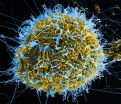(Press-News.org) A study recently published in the Journal of the American Academy of Dermatology shows that for Ebola, measles, syphilis and many other conditions with skin manifestations the mortality rates are hundreds of times higher in developing countries than they are in developed countries. The case of Ebola, the paper writes, "Highlights the importance of monitoring disease burden in the developing world even when the burden is low."
"Our goal is to provide information about trends and patterns to bring to light what's going on around the world so that funds can be allocated and policy developed as needed," says Lindsay Boyers, medical student at Georgetown University, working in the lab or Robert Dellavalle, MD, PhD, MSPH investigator at the University of Colorado Cancer Center, associate professor of dermatology at the University of Colorado School of Medicine, and the paper's senior author.
The paper used data from the Global Burden of Disease Study, an ongoing project funded by the Bill and Melinda Gates Foundation to collect a billion data points describing the distribution of the world's diseases. Of the 269 diseases in the GBD database, this study compares rates in developed versus developing countries of Ebola, malignant melanoma, basal and squamous cell carcinoma, decubitus ulcer, bacterial skin diseases, cellulitis, varicella (including chickenpox, congenital varicella infection, and herpes zoster), syphilis, measles, and dengue.
Specifically, findings show that in 2010 the measles death rate was 197 times greater in developing countries than in developed countries, but this ratio was down from 345-to-1 in 1990. Syphilis death rates were 33 and then 45 times greater in developing countries in the years 1990 and 2010. And at the time of writing, 4,447 people had died of Ebola in developing countries compared with two in developed countries.
Of the diseases studied, only melanoma was higher in developed countries, at about 5 times the age-adjusted mortality as in developing countries.
"We have light-skinned populations in areas with tropical sun including Australia and New Zealand, and Asian populations don't tend to embrace tanning the way we do in the United States and many developed countries in Europe," says Dellavalle, explaining this higher melanoma incidence in developed countries.
Interestingly, dengue fever and dengue hemorrhagic fever had no higher age-adjusted mortality in developing countries than they did in the developed world. Dengue fever is a virus transmitted by mosquito in more than 110 countries resulting in more than 25,000 deaths per year.
The researchers suggest that in addition to the necessity of disease monitoring to help ensure containment of outbreaks such as Ebola, findings suggest that campaigns to eradicate measles in sub-Saharan Africa are effective but significant work is still to be done, and treatment of (and potentially a vaccine for) syphilis remains a major health challenge in developing countries.
A letter submitted by the authors as a late-breaking addendum to the paper suggests that the skin manifestations of Ebola have been under-reported, and that recognition of "non-proritic morbilliform eruptions" that may occur within 2-7 days of symptom onset could help early detection of the disease.
INFORMATION: END
Ebola highlights disparity of disease burden in developed vs. developing countries
2014-10-16
ELSE PRESS RELEASES FROM THIS DATE:
Rivers flow differently over gravel beds, study finds
2014-10-16
CHAMPAIGN, Ill. — River beds, where flowing water meets silt, sand and gravel, are critical ecological zones. Yet how water flows in a river with a gravel bed is very different from the traditional model of a sandy river bed, according to a new study that compares their fluid dynamics.
The findings establish new parameters for river modeling that better represent reality, with implications for field researchers and water resource managers.
"The shallow zones where water in rivers interacts with the subsurface are critical environmentally, and how we have modeled ...
Oh brother! Having a sibling makes boys selfless
2014-10-16
A new study brings good news to all the brothers out there: Having a sibling is just as good for you as it is for your sister.
That's surprising to family scholars because boys typically report that they benefit less than girls from peer relationships.
"In our study, most relationships were not as important for boys as they were for girls," said study co-author Laura Padilla-Walker. "But the sibling relationship was different – they seemed to report relying on sibling affection just as much as girls do. It's an area where parents and therapists could really help ...
New catalyst could improve biofuels production
2014-10-16
PULLMAN, Wash. – Washington State University researchers have developed a new catalyst that could lead to making biofuels cheaply and more efficiently.
Led by Voiland Distinguished Professor Yong Wang, the researchers mixed inexpensive iron with a tiny amount of rare palladium to make the catalyst. Their work is featured on the cover of the October issue of the journal ACS Catalysis.
Removing oxygen for better fuel
Researchers, government leaders and industry leaders are interested in renewable biofuels as a way to reduce national dependence on fossil fuels and ...
Older adults satisfied with aging more likely to seek health screenings
2014-10-16
ANN ARBOR—Adults over 50 who feel comfortable about aging are more proactive in getting preventive health care services, a new University of Michigan study found.
Sometimes, the older population does not visit their doctor because they believe that physical and mental declines typify old age, says Eric Kim, a U-M doctoral student in clinical psychology. They think that lifestyle changes will not make a difference, making them less likely to seek preventive care. This is not true and also not a healthy mindset, he says.
Studies show that older adults can go down ...
A simple and versatile way to build 3-dimensional materials of the future
2014-10-16
Kyoto, Japan — Researchers in Japan have developed a novel yet simple technique, called "diffusion driven layer-by-layer assembly," to construct graphene into porous three-dimensional (3D) structures for applications in devices such as batteries and supercapacitors. Their study was recently published in the journal Nature Communications.
Graphene is essentially an ultra-thin sheet of carbon and possesses exciting properties such as high mechanical stability and remarkable electrical conductivity. It has been touted as the next generation material that can conceivably ...
Have you heard of sudden unexpected death in epilepsy?
2014-10-16
Sudden unexpected death in epilepsy (SUDEP) is concerning and many—even those with seizure disorders—may not be aware of this condition. New research published in Epilepsia, a journal published by Wiley on behalf of the International League Against Epilepsy (ILAE), reports that 76% of caregivers are more likely to have heard of SUDEP compared with 65% of patients with epilepsy.
Dr. Barbara Kroner, an epidemiologist with RTI International in Rockville, Maryland and lead author of the study says, "When someone with epilepsy dies suddenly we want to understand ...
e-healthcare may help reverse the trend of high CVD and obesity in China
2014-10-16
Beijing, 16 October 2014: The use of electronic health care services (versus more traditional methods) to reduce the high incidence of heart disease in China will be debated by leading cardiologists from around the world in Beijing, from 16 to 19 October 2014.
The 25th Great Wall International Congress of Cardiology & Asia Pacific Heart Congress & International Congress of Cardiovascular Prevention and Rehabilitation (GW-ICC & APHC & ICCPR 2014) will advocate a patient centered health care model that maximizes the use of limited medical resources so patients can improve ...
Camargue flamingos starved in freezing conditions in 1985 and 2012 mass mortalities
2014-10-16
1985 was one of the worst years in living memory for the flamingo population of the Camargue, France. Over a 15 day period in January, temperatures plummeted, the lagoons, ponds and salt pans where the birds feed froze and by the time the Arctic blast had loosened its grip, almost one third of the population was dead. 'The 1985 mass-mortality shocked a generation of conservationists,' says David Grémillet from the CEFE-CNRS, France. Alan Johnson, a conservation scientist at the Tour du Valat research center, France, who dedicated 50 years of his life to protecting ...
UK tops global league table for gullet cancer -- adenocarcinoma -- in men
2014-10-16
The study, from the International Agency for Research on Cancer (IARC), the specialist cancer agency of the World Health Organization, is the first to try and quantify the worldwide extent of each of the two main types of oesophageal cancer: squamous cell carcinoma, or SCC for short; and adenocarcinoma.
Rates of SCC have remained fairly stable or have even fallen over the past few years, but those of adenocarcinoma have risen, particularly in high income countries. In 2012, oesophageal cancer was the eighth most common cancer worldwide.
The researchers used data from ...
Health & Safety Executive, HSE, advice on pneumonia jabs for welders 'flawed,' say experts
2014-10-16
Over the past 20 years, a growing body of evidence has linked exposure to metal fumes with a heightened risk of developing, and dying from, bacterial lobar pneumonia.
It is not clear exactly why this happens, but there are indications that the tiny particles in welding fumes boost the stickiness of pneumococcal bacteria to the cells lining the airways of the lungs.
The scientific evidence was sufficient to prompt the government's independent advisory body, the Joint Committee on Vaccination and Immunisation (JCVI), to recommend in 2011 that employers offer welders a ...



